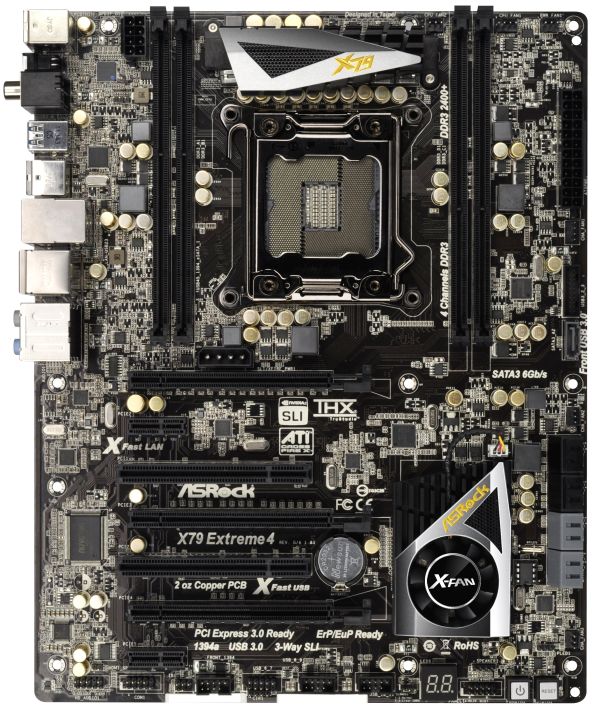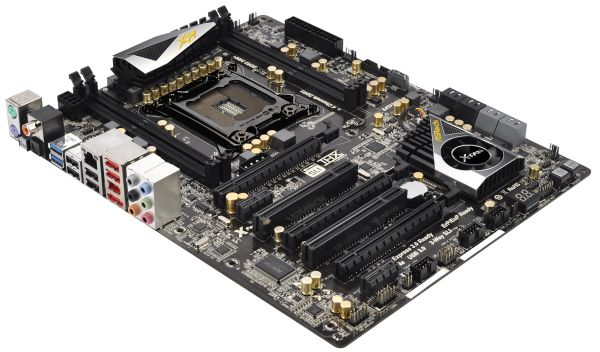ASRock X79 Extreme4-M and X79 Extreme4 Review – Sandy Bridge-E meets mATX
by Ian Cutress on December 9, 2011 12:00 PM EST- Posted in
- Motherboards
- ASRock
- X79
Overview
One of the first things people notice about the X79 Extreme4 is the price – a full size ATX board with the X79 chipset for ~$235 MSRP. As I mentioned in the X79 Extreme4-M overview, there will be demand for such cheap motherboards when more mainstream enthusiasts (rather than pure enthusiasts) may consider spending some, but not a lot, of money on a Sandy Bridge-E system.
With the ATX size, we can take full advantage of all the X79 features. In comparison to the X79 Extreme4-M, there is no lack of space for 40 PCIe lanes between the PCIe slots, there are more SATA 6 Gbps ports, the package has more to it (SATA cables, SLI connectors), and the board is tri-GPU possible. Some users may not like the fact that it has four memory slots (one per channel), but that is part of the reason why the board is cheaper than others. I will touch on this in the conclusion at the end of the review.
Performance on the whole was not too dissimilar to the X79 Extreme4-M, as expected. There were certain tests that this board would be slightly better on, and vice versa, but nothing outside the realms of statistical variance. Like the 4-M, despite the Realtek ALC898 audio, DPC Latency was a bit lacking compared to other X79 boards tested so far since release, probably due to BIOS configurations and maturity. The XFast LAN results however, as with Sandy Bridge P67/Z68 iterations, were a cut above the rest.
Visual Inspection
Perhaps it is just me, but I am starting to like the new ASRock styling. The black and gold angular PCH/heatsink style works quite well in my view of a top of the range motherboard, even if this is the more financially realistic end of X79 for the majority of users.
Despite the ability of having eight memory slots on X79, ASRock have decided to reduce the board price by only using one DIMM per channel, meaning four memory slots in total, here with quick release connectors. Given the abundance and low price of 4 GB DDR3 modules recently, and few power users requiring more than 16 GB of memory, using 4 DIMM slots is a good representation to save a few dollars on an overall system build perhaps. We will not be seeing all four memory slots on one side though, due to the pin layout of SB-E. As a result, the power solution to X79 boards are going to be squashed in the area above the socket itself – we see here ASRock have a heatsink covering the 6+2 phase VRM and chokes. A few vendors have this heatsink connected to a heatpipe and another heatsink below the socket, but again ASRock have left this out to save a few pennies.
Fan headers are in abundance, with a total of six. Two CPU headers and a PWR header on the top right, and a chassis header is underneath the 24-pin ATX power connector. Another chassis header is above the main block of SATA ports (which gets completely obstructed by any full length GPU in the first PCIe slot, and a third chassis header below the SATA ports (again, obstructed when a third full length GPU is in use).
Beneath the 24-pin ATX power connector is a USB 3.0 header, and a SATA 6 Gbps port, both provided by ASMedia controllers. The main block of SATA ports contains the typical ports from the Platform Controller Hub (four SATA 3Gbps in black, two SATA 6Gbps in gray), and another two SATA 6 Gbps provided via a controller. Next to this is the PCH itself covered in a black, gold and silver heatsink. As the heatsink is relatively small, ASRock have included a small fan connected to a small onboard header. This fan isn’t set to come on (by default) until the PCH reaches 50 degrees Celsius.
Despite this being one of the cheaper X79 options, we still get power/reset buttons, along with a two-digit debug LED useful for recognizing board issues. Aside from the usual array of headers on the bottom of the board, people will note the colorful use of gold capacitors on the board to tie in with the black/gold theme. ASRock argue in their marketing that these are premium conductive polymer caps – I hope they’re in some way premium, with this being X79.
In terms of PCIe layout, we have good and negative points. At the top is a 4-pin molex connector designed to give the PCIe extra power. For all intents and purposes, I found this largely useless, as two GTX580 GPUs ran quite happily without issue, as they already have their own power connectors and the PCIe specification should provide more power through the slot. It is also in an awkward place, for cable management inside a case. Nevertheless, we cannot really poke holes in the PCIe layout – at the top is a PCIe x16, x1, PCI, x16, PCI, x8, x1. I am thankful for the triple slot gap between the first two GPU x16 slots, and there is some space for any PCIe x1 card at the bottom. This is slightly different to what we normally see when PCIe lanes are at a premium – normally the x1 is at the top.
The back panel layout is identical to the X79 Extreme4-M. To quote, ‘From left to right, we see two PS/2 connectors, a clear CMOS button, a coaxial SPDIF out, an optical SPDIF out, two USB 3.0 ports, six USB 2.0 ports, gigabit Ethernet (Broadcom BCM57781), eSATA 6 Gbps, FireWire, and audio headers. For a board this price and on X79, we do not see much extra from what we would expect to be the standard.’












54 Comments
View All Comments
Tom Womack - Monday, December 12, 2011 - link
I'm a computational mathematician; SNB-E is interesting because it's a fast processor with four fast memory controllers. I have no desire whatsoever for crossfire; I'd be happy with an on-board ATI Rage128 and no PCIe slots, if that made the board a hundred dollars cheaper. I don't really need SATA controllers; USB stick with the OS on and data on NFS is fine by me. But I would quite like eight DIMM slots because I use memory as if it's going out of fashion.Is there a product for this market?
opti2k4 - Monday, December 12, 2011 - link
I have Asrock p67 extreme4 and i am curious did you test manual voltage settings of CPU vCore ?Few different boards and different chipsets have same bug. When you put manual vcore value in bios, you turn off computer and power it on, vcore is not the set vaule, instead it's on value that would be when you put automatic settings.
So my i7 2600k has 1.165V set in bios, when i power on computer its is on 1.3V!!!! Then i have to go inside BIOS, pick any other different value (1.160V), save and exit and just then the correct voltage value is set on vcore. Then again i have to restart and put back 1.165V. This fault is generated by very bad bios coding of asrock engineers. I'll never go to cheaper solution again, Asus FTW!
Regards,
opti2k4
kwokfc - Monday, December 26, 2011 - link
1.368v load @ 4.8Ghz HT on. Bios 1.6 Aircool with NH-D14. So far so goodNPWW - Friday, October 9, 2015 - link
Can someone help me. If I want to run a simple test off this motherboard using only bare minimum hardware, What do I need? Hard drive, power supply, memory, fan and ect